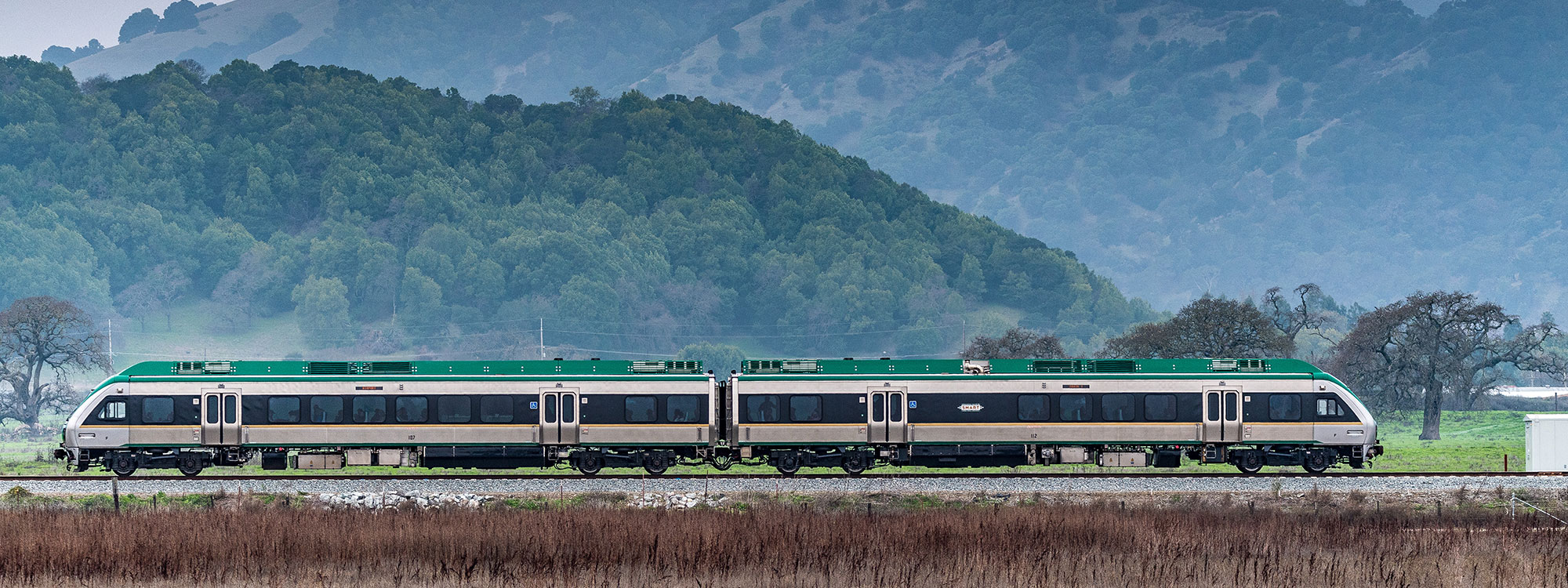Greenbelt Alliance was instrumental in generating public support to build the SMART train that connects Marin and Sonoma counties to the rest of the Bay Area. Now we need to keep the train on track toward completion. Please vote Yes on Measure I to renew the existing quarter-cent sales tax. For a full briefing on the train and why we need to keep it alive, read the following piece by Steve Birdlebough, Friends of SMART.
By Steve Birdlebough, Friends of SMART
In 2008, voters decided to fund the Sonoma Marin Area Transit (SMART) project. Unfortunately, it has proved too hard to deliver the entire ambitious vision in 2008’s Measure Q within just a few years. The Great Recession was well underway when the first quarter-cent sales tax receipts came in, so available funds were much lower than predicted. It also took longer than expected to get the needed permits for construction of the track and pathway, and by the time a contract to build the project could be negotiated, construction costs were rapidly rising. The project was being financially whipsawed. The SMART Board had to deliver rail service and the multi-use pathway in less ambitious stages.
Accomplishments of SMART
Over the past ten-plus years, we’ve seen an initial segment serving 10 stations, followed by the extension to Larkspur, with expected extensions north of the Sonoma County Airport as State and Federal funding allows. Segments of the bike-pedestrian path are necessarily built following reconstruction of the roadbed and tracks and when funding becomes available. About a third of the active right of way now has a completed pathway and several additional segments are funded and in various stages of completion.
To realize these accomplishments, SMART needed a talented General Manager with extensive local experience in infrastructure projects. Although Farhad Mansourian inherited an underfunded mandate, a vision he didn’t originate, and rail vehicles he didn’t select, he was able to assemble a highly capable team and build the system we have today. To do so, SMART secured $323 million of capital funding grants from state and federal programs. While some may question Mr. Mansourian’s style, it is hard to ignore his accomplishments.
Many of us fail to appreciate the extreme difficulty, cost and time required to build infrastructure projects of any kind in the US. High labor and material costs in a growing economy, layers of often conflicting regulations and permitting requirements, obtaining the approval of the Federal Railroad Administration, and satisfying the needs of numerous cities and stakeholders are only a few of the challenges the SMART team faced.
SMART was also required to implement the first Positive Train Control system for a new passenger railroad in the US. An outdated bridge over the Petaluma River had to be replaced, and SMART saved millions of dollars by bringing a slightly used drawbridge in from Texas, restoring it to nearly new condition. What the SMART team has achieved in a short time with few hiccups is remarkable.
The Benefits of SMART
Train service is expected to improve air quality and the environment generally. As an example, SMART has published calculations showing that the trains have thus far operated with one-third less greenhouse gas emissions (climate changing GHG) than the automobiles that it has taken off the road. This benefit is likely to improve because the number of train riders is likely to increase. SMART opponents assume that the current railcar emissions will continue, and that greenhouse gas emissions from buses and automobiles will decline as electric cars become more common. The critics of SMART fail to mention the possibility that SMART may shift to renewable biodiesel fuel or transition to other sources of power in the future.
Neither side has cited the significant amounts of harmful particulate pollution created by rubber tires and road dusts that the railroad avoids.
Tailpipe emissions and dust are some of the elements affecting the large ecological footprint of residents in the North Bay. SMART and the bikeway can help by enabling residents (particularly younger and older people in Sonoma County) to reduce their dependence on automobiles in walkable communities with smaller apartments along the rail/bikeway corridor. Apartments with common walls use less energy for heating and cooling and contain far less embodied energy. They also contain fewer resource-consuming possessions than suburban single-family homes.
Electric bikes are making it possible for people living 3-4 miles from a train station to commute by train if their workplace is also within easy cycling distance of a station. This is a huge economic benefit in that many more people can conveniently seek employment in a much larger area than before, and employers can attract more workers up and down the corridor.
Transportation is subsidized in many ways, and SMART’s critics try to show that operating subsidies for rail transportation is more costly than buses or private automobiles. However, SMART staff points out that the differential is minor and likely to diminish as train ridership grows. In 2018 the subsidy for the train averaged about $1.48 per passenger mile, compared with $1.21 per mile for the ferry and Golden Gate Bus combined. The subsidies for driving are imbedded in numerous practices and laws, most notably the way that we include the cost of parking in rent and public infrastructure. This article by Gregory H. Hill, University of Iowa, College of Law goes to great lengths to describe the legal favors afforded to driving.
A 2017 Federal study stated that, “In addition to helping to understand the rationale for subsidies, social costs and benefits may provide a better way of normalizing the magnitude of subsidies. A strong case can be made that comparing the magnitude of the subsidies to the magnitude of net social benefits, by mode, provides a better view of the relative subsidy than does normalizing by a physical measure such as passengers or passenger-miles. We have not included analysis of the social costs and benefits of different transportation modes because of the difficulty of providing a value of these costs and benefits.”
Because SMART has been operating for just over two years, we have only a glimpse of its future ridership, benefits, and costs. It’s in its infancy. Commuter ridership is rising and will probably increase with the Windsor and Larkspur extensions. It would be shortsighted to use a few statistics as the basis for deciding SMART’s fate.
Greenbelt Alliance is urging residents of Sonoma and Marin counties to support the SMART sales tax renewal by voting yes on Measure I on March 3, 2020. If passed, Measure I will renew the existing one-quarter cent sales tax to fund the Sonoma-Marin Area Rail Transit (SMART) for another 30 years. Learn more about Measure I here.
Please contact North Bay Regional Director, Teri Shore, for questions about SMART.
Photo: Jim Maurer via Flickr





